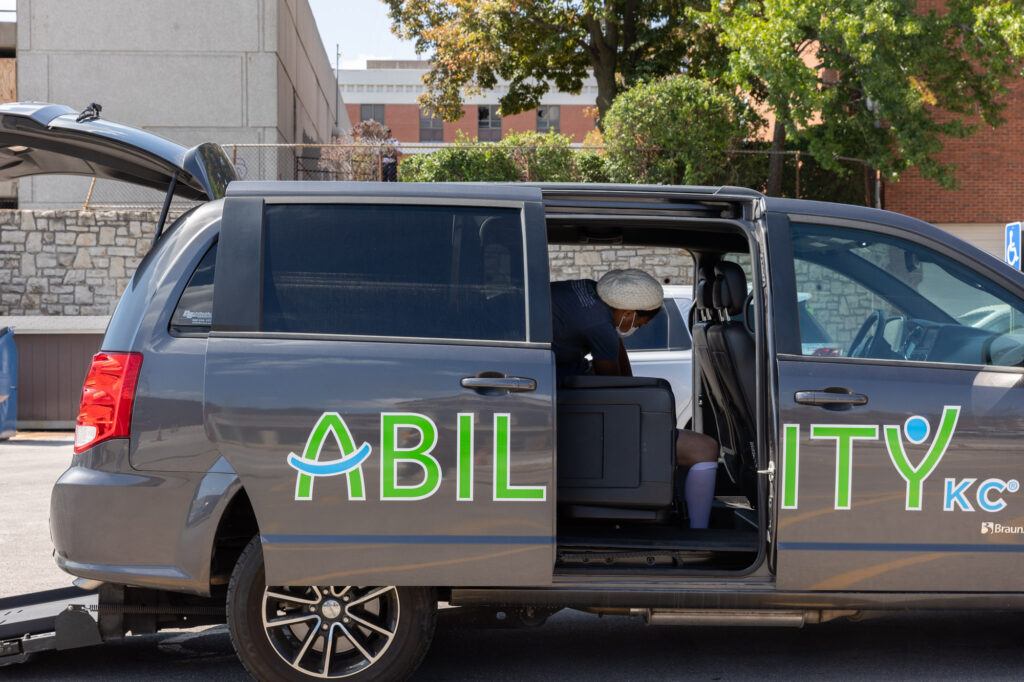
After a motorcycle accident, Nate was able to walk with a prosthetic after only five and a half months of rehabilitation at Ability KC. A Marine Corps veteran and former Kansas City, Missouri, police officer, he had more than enough determination and resilience to achieve his goals through our outpatient day program.
But you don’t have to be a soldier to adapt to daily life after a leg amputation. This article will outline what adjustments you may need to make and what your rehabilitation process might look like.
How can I adjust my activities of daily living with an amputated leg?
When living with an amputation, it’s possible to do many of the things you could do before the amputation. With some time, many amputees can drive their car and go back to work. Some people can walk and run freely with a prosthetic, and others may still need a cane or a walker. Some can even run or ride a bike. Prosthetics today are more comfortable, functional and lifelike than they were just a few years ago. Ask your doctor if you may be a good candidate for a prosthetic. If not, your doctor and your therapists will be able to help you troubleshoot daily activities.
A big part of the recovery process that many underestimate is the emotional adjustment. Losing a limb can be traumatic, and you may experience a long period of grief. Therapists and peer support groups will both be instrumental during the first phase of recovery. The length and the outcome of your recovery period will largely depend on your health prior to the amputation and your motivation.
What life activities will be limited after a leg amputation?
You will have some limitations during the healing phase. You’ll receive medication for pain, and if you’re feeling any phantom pain, there’s medication for that too. You’ll have limited mobility, and you won’t be able to submerge your leg in water. You’ll need to use a shower bench until the wound heals.
Rehabilitation starts a couple of days after surgery with some gentle exercises to keep blood clots from forming and keep your limbs strong. An occupational therapist will help you learn how to do activities of daily living while you’re healing, like showering and using the bathroom.
There are ways to adjust almost any activity to fit your abilities. Most often, it’s a matter of adapting the environment or other equipment to accommodate you, for instance, freeing up your hands for extra stability while walking with a cane. Things that require feeling in your feet can be tricky, like climbing a ladder. Your prosthetist will become a lifelong partner in crafting artificial legs to suit different conditions and functions. There are also plenty of life hacks you can learn from other amputees.
What kinds of rehabilitation will I need?
The major components of your rehabilitation will be healing the residual limb, having a prosthetic made for you, getting your strength back and learning to use your new prosthetic. The length and outcome of your recovery period depend on a few different factors. Your age, the severity of the amputation, any vascular disease and any falls that happen during rehabilitation can also affect your recovery time. One of the first things you’ll learn in physical therapy while you’re still healing is how to prevent yourself from falling.
You may need any of the following types of rehabilitation therapy after a leg amputation:
- Physical therapy — A physical therapist can help you with balance, walking, strength and range of motion.
- Occupational therapy — Occupational therapy is about learning to do specific tasks again, like showering and using the bathroom.
- Psychotherapy — Talk therapy will help you process your grief, rediscover your identity and manage feelings that come up during rehabilitation.
- Mirror therapy — This can help with phantom limb pain. You can use a mirror to “trick” your brain into believing your leg is there.
- Aquatic therapy — It’s much easier to balance with the resistance and buoyancy of water holding you up. Aquatic therapy is a low-impact way to build strength.
- Group therapy — Connecting with other new amputees helps you stay socially connected and motivated during recovery.
Exploring assistive technology
As soon as your residual leg is healed, you can start physical therapy with a prosthetic. It may take up to a year for the surface of your residual leg to fully heal and settle into its new shape. You might need to use one type of prosthetic while you’re recovering and get another one once you’ve regained your strength.
Your day-to-day activities will help inform your choice of prosthetic, if you choose to use one. They can be designed to function and look like a real leg. The process for getting a prosthetic takes longer for above-the-knee amputation.
People with prosthetics usually need to replace them every three to five years due to wear and tear or changes in their body composition and strength. If your prosthetic ever feels loose, uncomfortable, or unsteady, it may be time for a new one.
Ease the transition back to daily life with an amputated leg at Ability KC
Recovering from an amputation takes courage and grit. No matter what, even on the hard days, we’ll be there for you. Our community is here so you don’t have to do it on your own.
We accept most types of insurance, and we try to help eliminate barriers for anyone who needs our services. Learn more about our day rehabilitation program and outpatient services.
Contact our team today for more information or to schedule an initial appointment.